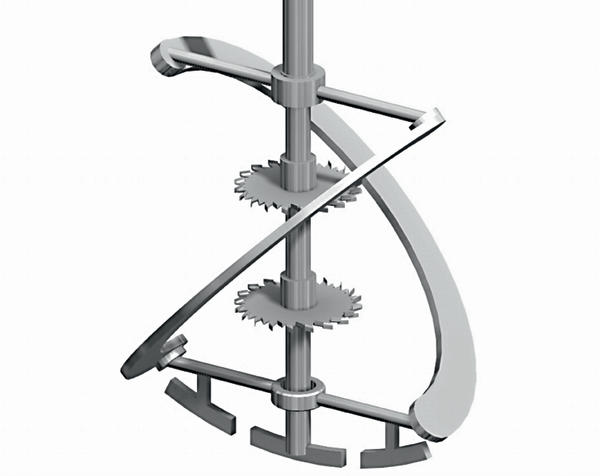Ekato manufactures a modular mixing system that is capable of processing products across all normal viscosity ranges. Several variations of the Ekato Paravisc system are used in the production of pharmaceuticals, for cosmetics such as salves, gels, toothpastes and shampoos as well as for a variety of foodstuffs. Another common application is for making pasty products like protective automotive coatings, adhesives, paints, varnishes and building materials.
By combining a set of individual components, the flexible modular design system can address the most diverse mixing requirements. It is thus possible to develop a single vessel capable of performing process steps that previously had to be carried out in separate vessels or to process several different products in one vessel. The modular system architecture provides the versatility necessary to cope with challenging mixing tasks.
The main component of this mixing system is the Ekato Paravisc. Products with a viscosity ranging from 1 to 1,000,000 mPas can be mixed using this impeller type. The Paravisc is an axial pumping impeller installed close to the wall that is typically used for blending highly viscous media. It works according to the positive displacement principle, similar to a helical ribbon impeller. However, in contrast to a helical ribbon, the design of the Paravisc only requires radial arms in the vicinity of the vessel base. It is therefore possible to install internal baffles and/or eccentrically arranged agitators that cover almost the entire filling height range. Compared to traditional anchor impellers, the Paravisc assures superior blending and entrainment due to the axial flows induced. The Paravisc has a blending time constant n*Q of n*Q = 20 to 60 across all viscosity ranges.
Intelligent combination of agitation components
Wall scrapers, which move to accommodate unevenness and irregularities in vessel shape, can be mounted on the Paravisc using round vertical supports. These scrapers are particularly useful when it comes to minimising fouling on vessel walls, eliminating residue – for instance during discharge – or improving heat transfer. The design of the wall scrapers can be adapted to the specific characteristics of each product. Robust, non-adjustable scrapers are mainly used if crust formation is likely. Flexible, GMP-compliant scrapers tend to be preferred for pharmaceutical and cosmetic applications; they adjust to unevenness simply by means of the product flow and do not need springs. Another useful component is the dissolver disc. This can be used as an off-centre mixing system and combined with a Paravisc to accomplish demanding dispersing tasks. One typical application for this duo is adding and dispersing large amounts of fillers – such as starch, lime, silica or synthetic powders – into viscous liquids.
The geometry of the Paravisc impeller base can also be modified to optimise the discharge of products from the vessel, for example using a Z-shaped anchor that moves the product to the central outlet of a dished vessel. If the vessel has a conical bottom, the Paravisc geometry can be matched to the shape of the cone, pushing the product towards the vessel outlet.
In some cases the bottom section of the Paravisc is left open in the centre. This is a good idea, for instance, if there is a risk that solids could block the vessel outlet. The gap allows a high-speed bottom impeller, driven by a separate concentric shaft, to be installed for the solids suspension step.
A Paravisc pumping upwards can be used to accelerate degassing of highly viscous products. This option creates low shear yet still allows surface movement. Small bubbles coalesce to form larger bubbles, which then collect and deform on the product surface and hence disengage more quickly from the liquid.
Ideal entrainment
The Paravisc can be combined with various other mixing systems to form a coaxial agitator. This is useful for high-viscosity applications or particularly demanding entrainment requirements. Vortex formation is increased when both agitator shafts rotate in the same direction, leading to behaviour that is ideal for entrainment. The two shafts of a coaxial agitator can also be rotated in opposite directions – reducing vortex formation and leading to higher shear forces compared to single-shaft systems. By installing a central impeller with a large diameter and then counter-rotating the Paravisc and this central impeller (or impellers), it is additionally possible to achieve a kneading action. Finally, the Paravisc can be united in a state-of-the-art solution with a rotor-stator system to facilitate minute particle or droplet dispersions.
cpp 428
Paravisc system (PDF)
Share:







